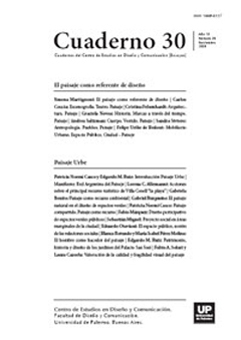Paisaje como recurso ambiental
Abstract
The modern city would seem to expel the nature until its limit. The substitution of the nature by the city rested,
partly, in an illusion of self-sufficiency and independence and the illusion of the possibility of a physical continuity without a conscious renovation. Under the protective mantle of the city, they were gotten to undermine the bases of social and economic structure not only of the surrounding landscape but also the one of distant regions. Many of the elements provided
by nature, necessary for both the physical and mental balance, began to be scarce within the cities. The progressive urbanization of the ground is related to many conflicts of the contemporary habitat. The public space, fundamental element of
the contemporary urban development, is the scene where collective life of those who inhabit the cities passes daily, and is
there where mainly they are materialized and the relations of being able between their inhabitants are expressed, as well as
its forms of organization. The new foundation of a public space as a polite and civilized place also supposes to recognize
the inexhaustible forms of the nature in the city
References
Charline, Claude (1999). Le régénération urbaine (París). Disponible en: http://www.habitat.aq.upm.es/boletin/n21/aafau.html
Clichevsky, Nora (1999) Tierra vacante en Buenos Aires: entre los loteos populares y las áreas exclusivas. En International Seminar on Vacant Land: Challenges and Oppotunities.Río de Janeiro Disponible en: http://www.habitat.aq.upm.es/boletin/n21/aafau.html
Di Marco, Alba; Novello, Alejandra; Asis, Mónica y Mas, Alberto. Arqtos. (2007). Gestión paisajística ambiental de vacancias urbanas en la ciudad de Córdoba. En V Congreso Iberoamericano de Parques y Jardines Públicos. Planeamiento y Gestión de los Espacios Verdes (Tucumán, Argentina)
Gómez Mendoza, Josefina (2003). Diseño urbano con criterios ecológicos, geográficos y sociales. Madrid, España. Disponible en http://habitat.aq.upm.es/boletin/n32/ajgom.html
Livingston, Rodolfo. Elogio al vacío. Clarín (Buenos Aires), 28 de agosto de 1984, Sección Opinión.
McHarg, Ian L. (1969). Design with Nature Doubleday, Natural History Press (Paperback 1971).
Mumford Lewis (1956). Historia natural de la urbanización. Chicago (EEUU). Disponible en http://habitat.aq.upm.es/boletin/n21/almum.html
Palermo, Marcela y Benito, Gabriela (2007). El uso de jardines de lluvia como mecanismo de restauración ambiental. En V Congreso Iberoamericano de Parques y Jardines Públicos. Planeamiento y Gestión de los Espacios Verdes (Tucumán, Argentina)
Silvestri, Graciela y Fernando, Aliata (2001). El paisaje como cifra de armonía. p 186. Ediciones Nueva Visión. Buenos Aires.
Svartz, Héctor y Benito, Gabriela N. (2007). Construcción de paisajes sobre suelos artificiales. En V Congreso Iberoamericano de Parques y Jardines Públicos. Planeamiento y Gestión de los Espacios Verdes (Tucumán, Argentina).
Westman W. E. (1977). How much are nature’s services worth? Science, 197: 960-964.
Los autores/as que publiquen en esta revista ceden los derechos de autor y de publicación a "Cuadernos del Centro de Estudios de Diseño y Comunicación", Aceptando el registro de su trabajo bajo una licencia de atribución de Creative Commons, que permite a terceros utilizar lo publicado siempre que de el crédito pertinente a los autores y a esta revista.


